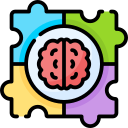Why Mindfulness Sharpens Attention
Regular mindfulness practice strengthens attention networks and reduces habitual mind-wandering. Studies report improved prefrontal control and less reactivity, which translates into clearer priorities, steadier focus, and calmer responses during high-pressure tasks or shifting priorities at work.
Why Mindfulness Sharpens Attention
When the mind drifts into the default mode, mindfulness labels the wandering without judgment and returns to an anchor. Over time, this gentle loop reshapes habits, making concentration feel more natural, compassionate, and reliably accessible.


